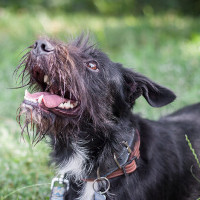Appearance of the Miniature Border Schnollie
|
| The Miniature Border Schmollie is a newer hybrid resulting from the breeding of Border Collie with Miniature Schnauzer and, as such, can take on some or all of the appearance traits of one or both of the parent breeds. Your adult hybrid will measure between 30.5 and 58.5 centimeters and weigh from 6 to 20.5 kilos, with males being slightly taller and heavier than females. The body may be square-shaped, small and sturdy or medium-sized and athletic, with a strong, blunt rectangular muzzle or a strong, slightly tapering muzzle of similar length to the tapering head, a nose that is solid black or of a color closely matching the coat color, ears set high on the head, V-shaped carried erect or partially or completely drooping, and a tail set low or high and of varying lengths. The eyes may be sunken and dark, making them sometimes grumpy, or they may be of any color depending on the coat color, and the two eyes may be of different colors. The coat can be wiry, rough or smooth with a thick undercoat and can be virtually any color. Colors you might see in your pet are: solid black, solid white, salt and pepper, black or silver, solid, bicolor, tricolor or merle composed of black, brown, red, beige, fawn or white. Your hybrid will probably inherit the scissor bite of both parent breeds. Your dog's feet may be oval and compact, or round and cat-like with arched toes. |
Temperament of the Miniature Border Schnollie
|
| Your Miniature Border Schnollie hybrid is a mix of Border Collie and Miniature Schnauzer and, as such, may inherit some or all of the temperament and personality traits of the parent breeds. Your hybrid pet could be alert, intelligent, friendly, playful, energetic, protective and responsive. It will be loyal and protective of its human family, being good with children as well as the family cat and other animals, although early socialization will help ensure this. This hybrid gets high levels of intelligence and energy from both sides of the biological equation, giving it a great desire to please. This makes this dog quite easy to train, provided you firmly establish from the outset exactly who is in charge. Stay positive in the areas of discipline and encouragement and you'll get much better results. It's prudent to mention one trait that could be important in the training arena. As previously mentioned, your hybrid can inherit personality traits from both sides of the organic mix. The Border Collie parent brings an almost eternal puppy formula to the organic mix. This means that your hybrid may not fully mature, physically and emotionally, until it reaches the ripe old age of 3 or 4 years. The playfulness doesn't detract from the obvious intelligence of this frisky hybrid mix. Your pet will probably also do well with strangers, but don't be surprised if he's a little noisier than usual until he's convinced the stranger's presence is safe. |
Needs and activities of the Miniature Border Schnollie
|
| Your Miniature Border Schnollie is a hybrid mix of Border Collie and Miniature Schnauzer and, as such, this hybrid will inherit large amounts of energy from both sides of the biological mix. These high levels of energy will need to be expended to keep your hybrid, and your family members, happy, fit and healthy. The energy and intelligence provided by the parent breeds create a canine dynamo in this hybrid mix. Both sides bring heritages that have engendered in them a need to keep moving, scanning, hunting, watching and guarding. These characteristics can force your hybrid to be kept mentally and physically challenged. Long daily walks, several times a day, combined with time to let off steam and play in the dog park or fenced backyard, retrieving and Frisbee games, earth dog activities, obedience and agility training are things that can help keep him busy, both mentally and physically. It's important to avoid boredom and the annoying destructive behaviors that can accompany it. Both parent breeds are considered “human” breeds and like to be around people, especially their human family. That said, it's important to note that your hybrid won't like to be left alone for long periods, suffering from separation anxiety. Your hybrid can tolerate both hot and cold temperatures, and can live in both urban and rural environments, although homes with open spaces may be better suited to his frontier side. It can, with a few modifications for exercise, live in apartments, condos or family homes with or without fenced yards. |
Maintenance of the Miniature Border Schnollie
|
| The Miniature Border Schnollie hybrid is considered a moderate maintenance dog, inheriting a minimal to moderate level of shedding from its parent breeds, the Border Collie and Miniature Schnauzer. The hybrid may or may not be hypoallergenic, as only the Miniature Schnauzer parent contributes to this trait. Since both parent breeds contribute dense double coats to the biological mix, you should expect to brush your dog at least once a week to remove loose hairs and other debris that may be present. Bathing your hybrid should be done only as needed, perhaps every few months, unless your pet likes to play in mud and puddles. Less frequent bathing will help preserve the oils his coat needs for good health. Your hybrid's ears should be checked at least once a week and cleaned without inserting anything into the ear canal to keep them clean and infection-free. Regular dental check-ups and cleanings, combined with at-home tooth brushing at least three times a week, will help reduce the risk of developing periodontal disease and the tooth loss that goes with it. Toenails should also be checked weekly and trimmed if necessary, unless the dog can keep them worn in normal daily physical activities. This hybrid inherits the low odor and drool of its parent breeds. |









 English (United Kingdom)
English (United Kingdom)